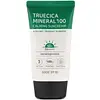What's inside
What's inside
 Key Ingredients
Key Ingredients

No key ingredients
 Benefits
Benefits

 Concerns
Concerns

 Ingredients Side-by-side
Ingredients Side-by-side

Water
Skin ConditioningCetyl Ethylhexanoate
EmollientButylene Glycol
HumectantGlycerin
HumectantDipropylene Glycol
HumectantZinc Oxide
Cosmetic ColorantSilica
Abrasive1,2-Hexanediol
Skin ConditioningNiacinamide
SmoothingPolyglyceryl-3 Methylglucose Distearate
EmulsifyingMelaleuca Alternifolia Leaf Water
AntimicrobialCI 77891
Cosmetic ColorantSodium Polyacryloyldimethyl Taurate
Emulsion StabilisingCetearyl Olivate
Sorbitan Olivate
EmulsifyingStearic Acid
CleansingCitrus Aurantium Dulcis Peel Oil
MaskingLauroyl Lysine
Skin ConditioningDisodium EDTA
Acrylates/C10-30 Alkyl Acrylate Crosspolymer
Emulsion StabilisingMelaleuca Alternifolia Leaf Oil
AntioxidantLavandula Angustifolia Oil
MaskingAdenosine
Skin ConditioningCentella Asiatica Extract
CleansingArtemisia Vulgaris Extract
Skin ConditioningCaprylyl Glycol
EmollientMadecassoside
AntioxidantAsiaticoside
AntioxidantAsiatic Acid
Skin ConditioningMadecassic Acid
Skin ConditioningWater, Cetyl Ethylhexanoate, Butylene Glycol, Glycerin, Dipropylene Glycol, Zinc Oxide, Silica, 1,2-Hexanediol, Niacinamide, Polyglyceryl-3 Methylglucose Distearate, Melaleuca Alternifolia Leaf Water, CI 77891, Sodium Polyacryloyldimethyl Taurate, Cetearyl Olivate, Sorbitan Olivate, Stearic Acid, Citrus Aurantium Dulcis Peel Oil, Lauroyl Lysine, Disodium EDTA, Acrylates/C10-30 Alkyl Acrylate Crosspolymer, Melaleuca Alternifolia Leaf Oil, Lavandula Angustifolia Oil, Adenosine, Centella Asiatica Extract, Artemisia Vulgaris Extract, Caprylyl Glycol, Madecassoside, Asiaticoside, Asiatic Acid, Madecassic Acid
Water
Skin ConditioningPropylene Glycol
HumectantMyristyl Myristate
EmollientPEG-8 Distearate
EmulsifyingPEG-40 Stearate
EmulsifyingGlyceryl Stearate
EmollientPEG-100 Stearate
Sorbitan Stearate
EmulsifyingCetyl Alcohol
EmollientCarbomer
Emulsion StabilisingTriethanolamine
BufferingDiazolidinyl Urea
PreservativeHydroxyethylcellulose
Emulsion StabilisingMethylparaben
PreservativePropylparaben
PreservativeTetrasodium EDTA
 Reviews
Reviews

Ingredients Explained
These ingredients are found in both products.
Ingredients higher up in an ingredient list are typically present in a larger amount.
Water. It's the most common cosmetic ingredient of all. You'll usually see it at the top of ingredient lists, meaning that it makes up the largest part of the product.
So why is it so popular? Water most often acts as a solvent - this means that it helps dissolve other ingredients into the formulation.
You'll also recognize water as that liquid we all need to stay alive. If you see this, drink a glass of water. Stay hydrated!
Learn more about Water